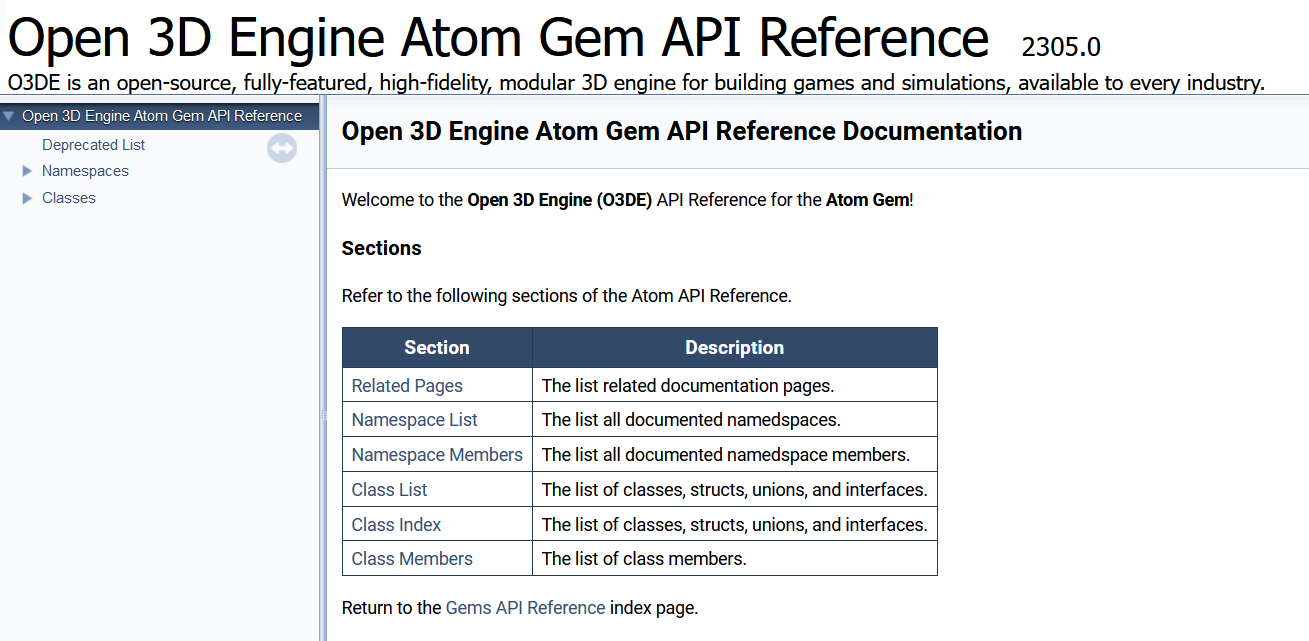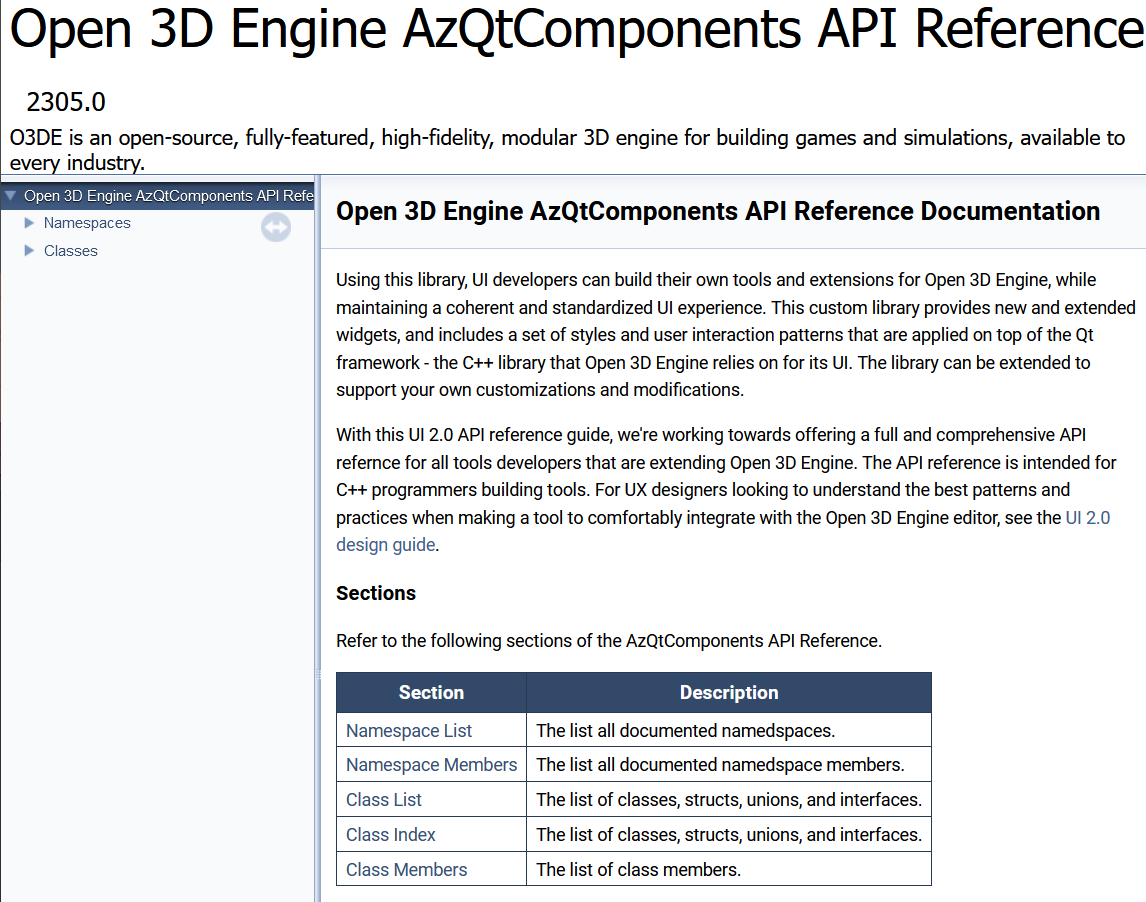README.md 7.3 KB
C++ API Reference Generation
The Open 3D Engine (O3DE) API Reference is generated using Doxygen. With the help of the API Reference Generation (o3de-doxygen) scripts to automate the process, an API reference is generated for all frameworks and Gems in the o3de repository by default. You may also configure the scripts to generate API references for Gems in other O3DE repositories.
Requirements
- Linux machine or Windows Subsystem for Linux (WSL)
- Clone of the
o3derepository in your machine - Clone of the
o3de.orgrepository in your machine - Doxygen installation
Set up
Download o3de-doxygen
- Clone the
sig-docs-communityrepository, which contains theo3de-doxygenscripts. - In the
toolsdirectory, find theo3de-doxygenscripts.
Install rust commands
The o3de-doxygen scripts use some efficient Rust commands for processing the source code in o3de. You must install Rust and the fd-find cargo to run the scripts properly.
Install Rust by using rustup, or by running the following command in your Linux machine:
curl --proto '=https' --tlsv1.2 -sSf https://sh.rustup.rs | shAdd rust to your environment variables.
source "$HOME/.cargo/env"Install the
fd-findcargo, which is a file searching tool:cargo install fd-find
Clean repos
The C++ API reference generation scripts runs Doxygen on your local o3de clone. Then it outputs the generated files into your local o3de.org clone. Therefore, before you generate the API, you must ensure that your cloned repos are clean and have the latest changes.
o3de
In your local
o3declone,git checkoutthe latest updates in thedevelopmentbranch, or in the case of a major O3DE release, thestabilizationbranch.git fetch --all git checkout upstream/<branch>- upstream: Set to track the source repo,
https://github.com/o3de/o3de.git
- upstream: Set to track the source repo,
Run
git cleanin your local O3DE clone.
o3de.org
In your local
o3de.orgclone,git checkoutthe latest updates in thedevelopmentbranch, or in the case of a major O3DE release, thestabilizationbranch.git fetch --all git checkout upstream/<branch>- upstream: Set to track the source repo,
https://github.com/o3de/o3de.org.git
- upstream: Set to track the source repo,
Create a new branch, such as
api-ref. This branch will contain the API reference docs that you will generate later.git switch -c api-refMake sure the
api-refbranch is clean from any untracked files or changes. The branch should be at the same state as the upstream branch's HEAD. To clean, rungit clean,git reset, orgit stashas needed.
Prepare scripts
In
config.shset the following variables:O3DE_PATH: Path to your local o3de clone (e.g. $HOME/o3de)O3DEORG_PATH: Path to your local o3de.org clone (e.g. $HOME/o3de.org)
The C++ API reference generation scripts read from
o3deand write too3de.org.If this is your first time running the script, you may need to enable permissions to execute the program. In the
o3de-doxygendirectory, run the following:cd <path-to>/o3de-doxygen chmod +x *.sh
Generate
The following scripts generate the frameworks and Gems APIs.
Frameworks API
In the o3de-doxygen directory, run the script:
./o3de-framework-apis.sh
This generates the following files in o3de.org:
content/docs/api/frameworks/_index.mdstatic/docs/api/frameworks/*
Gems API
Note: You must install rust commands to run o3de-gem-apis.sh.
In the o3de-doxygen directory, run the script:
./o3de-gem-apis.sh
This generates the following files in o3de.org:
content/docs/api/gems/_index.mdstatic/docs/api/gems/*
Publish
After generating the C++ API reference and supplemental files, it's time to publish them on the website. When you cleaned your o3de.org clone, you set up a new clean branch, such as api-ref, and when you generated the APIs, the files were placed in that branch.
To publish the newly generated APIs, you must run git add, git commit, git push, and create a new pull request. For guidance through each step, please refer to the O3DE Docs Contributions: Runbook.
Generating for Gems outside of o3de
In some cases, the O3DE API Reference must include the API for code that lives outside of the o3de repository. This is typically decided by O3DE members and the Release Special Interest Group (SIG). For example, a major O3DE release may include new Gems that live in the o3de-extras repository.
To generate API References for Gems outside of o3de:
Move the Gem's directory into the
Gemsdirectory of your localo3declone.
Customizing the API's main page
The main page is the first page you see when you open a framework or Gem's Doxygen-generated API reference. For example, open any framework or Gem in the API docs. The contents of the main page is either automatically generated, or specified by the developer by using the Doxygen command, /mainpage, in the code's comments.
By default, if /mainpage is not specified, an API's main page includes a brief introduction and a table of contents, like the following:
If a developer documents the API using /mainpage, it will replace the default introduction. However, you may still insert the table of contents by adding o3de-doxygen-insert-table to your /mainpage comment block. For example, this comment block in the AQtComponents's source code generates the following main page.
/**
* \mainpage
*
* Using this library, UI developers can build their own tools and
* extensions for Open 3D Engine, while maintaining a coherent and standardized UI experience.
* This custom library provides new and extended widgets, and includes a set of styles and
* user interaction patterns that are applied on top of the Qt framework - the C++ library
* that Open 3D Engine relies on for its UI. The library can be extended to support your own customizations and modifications.
*
* With this UI 2.0 API reference guide, we're working towards offering a full and comprehensive
* API reference for all tools developers that are extending Open 3D Engine. The API reference
* is intended for C++ programmers building tools. For UX designers looking to understand
* the best patterns and practices when making a tool to comfortably integrate with
* the Open 3D Engine editor, see the [UI 2.0 design guide](https://o3de.org/docs/tools-ui/ui-dev-intro/).
*
* o3de-doxygen-insert-table
*
*/

